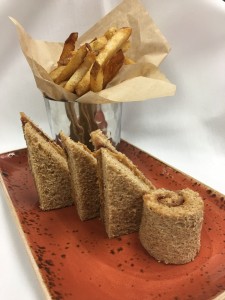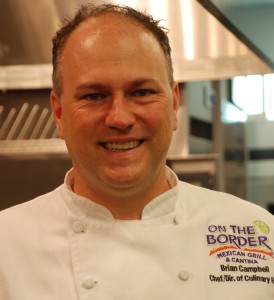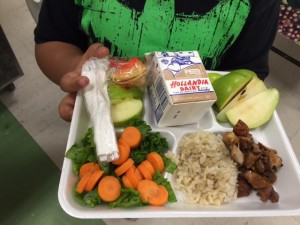
Familiar foods with healthier ingredients and reduced sodium is a positive start to improving kids’ menus. (Photo: Las Canarias & Ostra)
By Laurie Wiegler
In the 1960’s, the healthy part of a “kid’s” meal at a restaurant was the cherry in our Shirley Temples.
And who doesn’t remember slathering cold butter on her crackers as the waiter brought us mini steaks and fries, followed by chocolate pudding with a whipped cream topper. Even dentists gave us a lollipop after a teeth cleaning!
But the world has certainly changed – and not a bite too soon when it comes to curbing America’s child obesity epidemic.
The Fat Fight
According to the Centers for Disease Control, children are mirroring their older role models when it comes to excess weight. For sadly, the obesity rate “has more than doubled in children and quadrupled in adolescents in the past 30 years.”
Further, the link between poverty and higher obesity rates is clearly delineated – largely because food deserts, where lower-income families cannot find fresh fruits and vegetables, remain a striking problem in the U.S.
However, the restaurant industry and schools nationwide are stepping up; and believe it or not, McDonald’s is leading the charge. H.G. Parsa, professor at the Fritz Knoebel School of Hospitality at University of Denver, has been studying trends in healthier kids dining for years. He says it all began under the golden arches.
“McDonald’s is a trendsetter,” he says. “People follow the lead of McDonalds, who was the first to introduce chicken nuggets, and the first to introduce a kids’ menu. Then when they introduced a healthy kids menu (in 2012), others followed.”
It’s a message that has permeated beyond the coasts, where people typically think of slimmer waistlines and trends.
And this is key, because according to the CDC, in 2013 by the time kids got to high school in Texas, for example, the obesity rate was 16 percent.
This is one reason the state is making inroads to reverse its bigger-is-better reputation.

Chicken fingers made with organic chicken and lighter panko breadcrumbs are on the kids’ menu at Las Canarias and Ostra, two acclaimed restaurants in San Antonio.
“We use organic Texas chicken in our chicken fingers,” says San Antonio’s Omni La Mansión del Rio’s Shane Bruns, who’s making them with Asian panko, a crustless-based twist on the western breadcrumb. “It makes it lighter, and the not-so-heavy breading gives a crunchier taste.” Bruns is a former chef, and healthy food advocate, having worked in some of the country’s finest restaurants. He currently serves as the head of F&B at La Mansion del Rio and Mokara Hotel & Spa – which are home to Las Canarias and Ostra, two of the city’s most acclaimed dining establishments.
Bruns, a Colorodan who studied the culinary arts in San Francisco, is a big believer in the farm-to-table concept, which he’s brought with him to Texas. He also is able to explain why, for example, choosing hormone-free organic milk is key to keeping kids from growing too large, too fast.
He also knows not everything can be organic, or perfectly sourced, or low-fat when it comes to serving kids at restaurants.
“We try to balance what we think kids will eat or want to eat, with health-conscious parents wanting their kids to be a little healthier,” he says.
So he’ll whip up a PB&J, but uses honey whole wheat bread, organic peanut butter or almond butter, and a fresh fruit spread sans preservatives or high fructose corn syrup.
School’s Out, Nutrition’s Not
Another passionate promoter of healthier kids’ eating is Riverside, California’s Kirsten Roloson, assistant director of nutrition services for the school district. She’s been instrumental in bringing healthier options to students. “About 65 percent of our produce is grown locally; we are fortunate,” says Roloson.
Children from the aforementioned food deserts are not only being exposed to, but partaking enthusiastically of choices at salad bars at 30 elementary schools and “produce markets” at six lower-income schools.
She talked about a boy who couldn’t believe he got seconds at the salad bar.
“I’m just so happy it’s all-you can eat because now I don’t have to worry about dinner,’” he said. “Sometimes I don’t get dinner at home.”
Roloson is rightly proud of how the district is helping boys like him eat healthier, not just with the salads but now through a meal program that means a healthy breakfast and supper, too.
Guidelines Help Balance Food Choices
Nationwide measures – from the government’s Healthy Schools program to the Kids LiveWell program employed by several dozen restaurants in partnership with the National Restaurant Association – are helping parents improve their kids’ dining choices.
For example, at 140 restaurant brands nationwide – from Denny’s to Boston Market to On the Border Mexican Grill & Cantina – kids are eating healthier thanks to the five-year-old Kids LiveWell program, which promotes low-calorie, nutritionally balanced meals.

Brian Campbell, R&D director for On the Border restaurants, developed the kids’ lower-calorie “build your own mini taco” concept.
It’s a partnership with the National Restaurant Association through the 25-year-old Healthy Dining, which employs dietitians to choose lean proteins, fruits, vegetables, whole grains and low-fat dairy that will become kid-friendly creations.
On the Border’s director of culinary R&D, Brian Campbell, bubbles over when discussing the brand’s under-400-calorie options such as Build Your Own Mini Tacos.
“What kid wouldn’t love being ‘the chef’ and building their own tacos just exactly the way they want them?” he asks. “It’s like having permission to play with your food.”

Leave a Reply